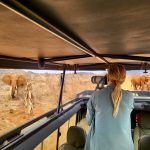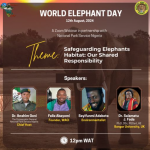Visit The Explorers Club World Elephant Week for the LIVE link on Facebook, YouTube, and Explorers.org
Day 1 — MONDAY – August 9
7:00 pm
Introduction
Jim Knox, Curator of Education at Connecticut’s Beardsley Zoological Society
7:15 pm
Intro to African Elephants
Grant Fowlds, Conservationist, consultant, and educator in South Africa
Overview: Grant is going to be recorded due to timezones. He will start us off with a short video from the field where he will take us on a little drive through the reserve to look at some elephants. During his talk Grant is going to give us a brief overview of African elephants, conservation issues with them, and some of the work he does.
7:30 pm
Intro to Asian Elephants – Why look at elephants?
Dr. Hannah Mumby, Assistant Professor University of Hong Kong
Overview: Watching elephants is one of the most interesting ways to spend time. Everything from the way they flap their ears to regulate their body temperature to the way the calves play. I’ve been lucky enough to elephants across Africa and Asia. In this talk, I’m going to give some examples of what my team looks at in elephants and why, including thermal photographs of elephants and what we can tell from them, why I’m interested in the weather calves are born and what we can see from elephant tusks. I’ll focus primarily on endangered Asian elephants, which a long history of living in close contact with humans. Elephants are my biggest source of inspiration and I look forward to talking to you about them!
7:45 pm
Elephant Trunks
Andrew Shultz, Ph.D. in Mechanical Engineering at Georgia Tech
Overview: Elephants are the largest terrestrial mammal in the world and their trunks have fascinated scientists since Darwin observed their behavior in 1871. Their trunks are made entirely of muscle a property like mammal tongues and octopi’s arms. The elephant had the precision to pick up a tortilla without breaking it but can also throw a lion away with ease. All this maneuverability and flexibility of the trunk is done with no bones and no joints which makes the trunk an ideal source of biological inspiration for soft robotics. Soft robotics is an up-and-coming field of using soft materials to allow for flexible movement similar to that of the elephant trunk. However, African bush elephants in 2021 were moved from vulnerable to endangered for their conservation status with current estimates showing them extinct in the wild by 2038. Therefore, we must work towards conserving elephants and other species in tandem with other scientific discoveries so future generations can experience these animals and their important impacts their natural habitats.



